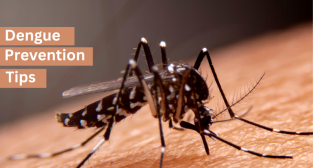
Fever: Causes, Types, and Effective Management for Early Recovery
Fever is an immune response of the body to combat infections which is associated with rise in the temperature. This increase in the body temperature activates diverse immune responses, augmenting their efficacy in warding off the invading infection. Typically, fever subsides within a couple of days with adequate rest, combined with appropriate medications and fluid intake. However, it is important to monitor the temperature along with any worsening symptoms during its occurrence to avoid complications.
Recording the temperature
Temperature is measured using clinical thermometer by placing it inside the mouth or under the arm (axillary). Normal body temperature ranges from 97°F (36.1°C) to 99°F (37.2°C). Elevated temperature above this range suggests individual experiencing with fever.
Symptoms of Fever
Fever symptoms vary among individuals, with certain common symtoms that include:
- Chills
- Sweating
- Low appetite
- Headache, Body pain
- Dehydration
- Lethargy
- Insomnia
- Loss of taste
- Nausea, Vomiting
Causes of Fever
Many conditions can lead to the manifestation of fever, serving as a potential indicator for underlying illness. Common causes encompass a range of factors, with the most prevalent ones being:
- Viral infection (cold and flu)
- Bacterial infection such as pneumonia, typhoid, urinary tract infection, etc,
- Fungal infection such as candidiasis
- Food poisoning
- Chronic illnesses such as cancer, arthritis, gastrointestinal disruptions, renal disease, asthma, etc.
Types of fever
The spectrum of fever severity encompasses a diverse range, some of the common types include:
- Acute fever: In this type there is slight and short-term increase in body temperature, greater than 100.4°F (38°C). Acute fevers typically emerge rapidly and may persist for a duration ranging from a few days to several weeks.
- Sub-acute fever: This type of fever typically remains for weeks to months, which are commonly observed in the case of infections or other illnesses.
- Chronic or persistent: This type of fever implies a prolonged elevation in body temperature that continues for an extended period, frequently exceeding three weeks.
- Recurrent Fever: This type of fever recurs with 3 or more episodes in 6-month period with the gap of 7 days and with no sign of any medical illness.
- Hyperpyrexia: It is also termed as very high fever with body temperature more than 106.7°F or 41.5°C. High fevers are symptoms, not illnesses, often resulting from infections like viral or bacterial infections.
- Typhoid fever: It is fever caused by salmonella typhi a bacterium that contaminates food. It can cause serious complications and can be fatal if not treated promptly.
- Dengue fever: A viral fever, ranges from asymptomatic to severe illness. Treatment involves fluids, pain reliefs, severe cases may require hospital care.
Fever Treatment
Generally, viral fever typically resolves naturally and proper rest, medication, and hydration can contribute to a quicker recovery. While fever caused by bacterial infections requires antibiotics prescribed under the guidance of physician. Generally, fever itself is not dangerous, but it is essential for one to take below measures for a quicker recovery:
- Stay hydrated with water, juice, or clear soup.
- Include food plate with easily digestible diet.
- Ensure adequate rest.
- Consider a warm sponge bath for comfort.
Over-the-counter medications for fever
Over-the-counter medications can help to alleviate symptoms like headache, body ache, and muscle pain associated with fever. In severe cases, treatment depends on identifying the underlying cause. Doctors may advise lab test based on the severity to prescribe antibiotics, antivirals, or antifungals for any serious infections. However, experts emphasize strict adherence to prescribed doses to avoid adverse effects like liver damage, renal inflammation, and antibiotic resistance.
Conclusion
Fever is an immune response against infections, which often resolves with prompt measures. Monitoring temperature and seeking medical attention for persistent symptoms is important. Differentiating causes, types, and appropriate treatments, underscores the importance of strict adherence to prescribed medications to prevent further complications.



















